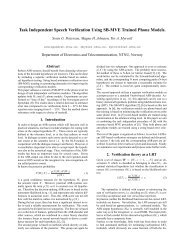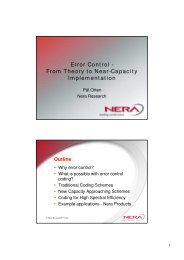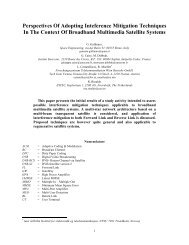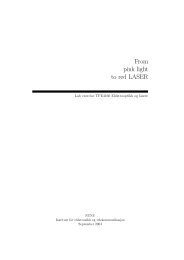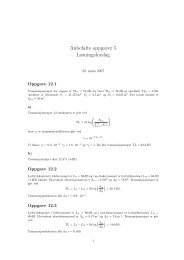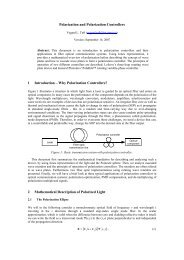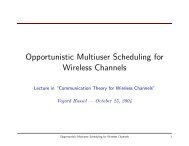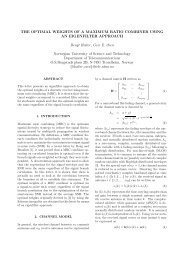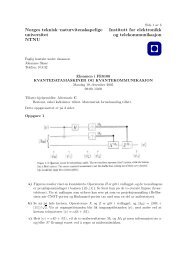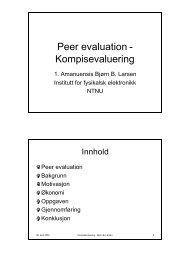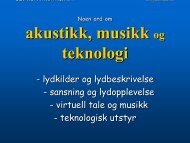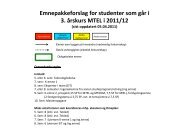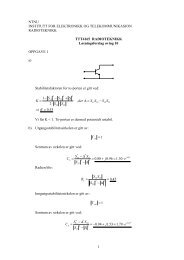LDPC CODED ADAPTIVE MULTILEVEL MODULATION ... - NTNU
LDPC CODED ADAPTIVE MULTILEVEL MODULATION ... - NTNU
LDPC CODED ADAPTIVE MULTILEVEL MODULATION ... - NTNU
Create successful ePaper yourself
Turn your PDF publications into a flip-book with our unique Google optimized e-Paper software.
<strong>LDPC</strong> <strong>CODED</strong> <strong>ADAPTIVE</strong> <strong>MULTILEVEL</strong> <strong>MODULATION</strong> FOR SLOWLY<br />
VARYING RAYLEIGH-FADING CHANNELS<br />
Bård Myhre<br />
SINTEF Telecom and Informatics<br />
N-7465 Trondheim<br />
bard.myhre@informatics.sintef.no<br />
Vidar Markhus and Geir E. Øien<br />
Dept of Telecommunications, <strong>NTNU</strong><br />
N-7491 Trondheim<br />
{vidar.markhus, geir.oien}@tele.ntnu.no<br />
ABSTRACT<br />
Adaptive coded modulation is a promising idea for<br />
bandwidth-efficient transmission on time-varying wireless<br />
channels. On power limited Additive White Gaussian<br />
Noise (AWGN) channels, low-density parity-check<br />
(<strong>LDPC</strong>) codes are a class of error-control codes which<br />
have demonstrated impressive error-correcting qualities,<br />
under some conditions performing even better<br />
than turbo codes. We propose a combination of these<br />
two principles: A rate-adaptive <strong>LDPC</strong>-coded modulation<br />
scheme designed for slowly varying flat fading<br />
channels. The scheme’s theoretical performance<br />
is evaluated by calculating its bandwidth efficiency<br />
for a given target bit error rate (BER). Finally we<br />
extend the scheme to an effectively zero-error hybrid<br />
FEC-ARQ system, without degrading bandwidth efficiency.<br />
Keywords: Rate-adaptive modulation, error control<br />
coding, flat-fading channels, <strong>LDPC</strong> codes, ARQ.<br />
1. INCREASING WIRELESS SPECTRAL<br />
EFFICIENCY BY LINK ADAPTION<br />
Future generations of wireless communication systems<br />
will have to include some form of link adaptation,<br />
i.e., rate-adaptive transmission schemes, inorderto<br />
increase the throughput of information to the levels<br />
demanded by high-quality multimedia services. This<br />
is because wireless and mobile channels exhibit timevarying<br />
channel-signal-to-noise ratio (CSNR), usually<br />
caused by multipath reflections, shadowing, and the<br />
relative movement between transmitter and receiver<br />
in a mobile system. Upcoming Wireless Local Area<br />
Network (WLAN) standards such as Hiperlan/2 are<br />
already beginning to explore link adaptation as a means<br />
towards increased spectral efficiency, by means of punctured<br />
convolutional codes.<br />
One variant of the link adaption idea is to transmit<br />
with constant power, but to adapt channel coding<br />
and modulation in such a way that highly bandwidth<br />
efficient multilevel coding is used when the CSNR is<br />
high, and less bandwidth efficient coding (more redundancy)<br />
is used when the CSNR is low. This assumes<br />
that the transmitter has access to the channel<br />
state information (CSI) at any time. For slowly varying<br />
channels (those with limited mobility and thus<br />
limited Doppler shifts) the CSNR can be regarded as<br />
nearly constant for shorter periods of time (the coherence<br />
time), which makes it possible too feed back CSI<br />
to the transmitter using a feedback or return channel.<br />
During a time interval of length less than the coherence<br />
time the channel can now be well approximated<br />
by an AWGN channel. An efficient transmission<br />
scheme designed for an AWGN channel with the<br />
same stationary signal-to-noise ratio will therefore be<br />
a good scheme for a flat fading channel, as long as the<br />
scheme does not require processing of blocks longer<br />
than the channel coherence time. When choosing<br />
the individual channel codes employed in an adaptive<br />
scheme, one should thus ensure that each code<br />
has satisfactory performance on an AWGN channel<br />
within some certain CSNR range. One could say that<br />
the principle of adaptive coded modulation effectively<br />
reduces a time-varying channel to a ”bank” of timemultiplexed<br />
AWGN channels, each of which is to be<br />
used to represent some finite (small) interval on the<br />
CSNR axis. This is beneficial since the search for good<br />
codes on AWGN channels is a problem which has been<br />
subject to much research and large breakthroughs in<br />
the last decade.<br />
2. THE FLAT FADING CHANNEL MODEL<br />
The flat-fading channel is a much-used model for narrowband<br />
transmission over wireless and mobile communication<br />
channels, and the one to be used here. On<br />
a flat-fading channel, all signal frequencies are attenuated<br />
by the same factor. The received signal y k in<br />
the complex baseband domain can then be written at<br />
a given time instant k as<br />
y k = a k x k + z k (1)
where a k is the fading amplitude, x k is the transmitted<br />
channel symbol (in general complex), and z k is<br />
complex AWGN. The fading amplitude is also in general<br />
complex, but may be assumed to be real-valued<br />
if perfect coherent detection is assumed at the receiver<br />
end. We shall adopt this commonly used assumption<br />
throughout this paper.<br />
The fading amplitude a (for notational simplicity<br />
we suppress the time dependence from now on) can be<br />
described as a stochastic variable, whose distribution<br />
we assume to be known. One particularly interesting<br />
distribution is the Nakagami distribution [9]:<br />
p A (a) = 2 ( m<br />
) m<br />
a 2m−1<br />
Γ(m) 2σ 2 e −ma2 /2σ 2 (2)<br />
Here, m> 1 2<br />
is the Nakagami parameter, σ2 is the<br />
fading amplitude variance, and Γ(x) is the gamma<br />
function defined by<br />
Γ(x) =<br />
∫ ∞<br />
0<br />
y x−1 e −y dy, x > 0. (3)<br />
The Nakagami distribution is of such interest because<br />
it allows for modelling of a wide range of fading environments<br />
by varying m, while yielding closed-form expressions<br />
for many interesting features of the channel,<br />
such as channel capacity. For m = 1 the model corresponds<br />
to the Rayleigh fading model which is common<br />
in mobile communications when there is no line-ofsight<br />
(LOS) path between transmitter and receiver.<br />
Increasing m will model less severe fading environments.<br />
If a is Nakagami distributed, the CSNR will be<br />
Gamma distributed as shown in Equation (4), γ and<br />
γ being the instantaneous and expected CSNR respectively<br />
[4].<br />
( ) m m γ m−1<br />
p γ (γ) =<br />
(−m<br />
γ Γ(m) exp γ )<br />
, γ ≥ 0 (4)<br />
γ<br />
Under the assumption of perfect knowledge of the<br />
channel state information (CSI) both on the receiver<br />
and transmitter side, the maximum average spectral<br />
efficiency (MASE), or channel capacity, of a Nakagami<br />
multipath fading (NMF) channel has been shown<br />
to be given by [1, Eq. 23]<br />
m−1<br />
∑<br />
MASE = log 2 (e)e m/γ<br />
k=0<br />
( m<br />
γ<br />
) k (<br />
Γ −k, m )<br />
γ<br />
(5)<br />
where Γ(x, y) is the socalled complementary incomplete<br />
Gamma function, which is commonly available<br />
in numerical software such as MATLAB or Maple.<br />
The MASE provides an ultimate performance benchmark<br />
for the spectral efficiency of any practical communication<br />
system communicating over this channel.<br />
It has been shown that in order to efficiently exploit<br />
the channel’s capacity over time without excessive<br />
delay, a transmitter should switch between different<br />
codes of different spectral efficiencies—in other words<br />
adapt itself to the changes in channel quality as done<br />
by adaptive coded modulation.<br />
3. ACHIEVING CAPACITY ON AWGN<br />
CHANNELS: <strong>LDPC</strong> CODES<br />
In [10, 13] it is shown that carefully designed Low-<br />
Density Parity Check (<strong>LDPC</strong>) codes almost attain<br />
the Shannon channel capacity, i.e. the ultimate performance<br />
limit, for AWGN channels with BPSK modulation.<br />
The reason for this record-breaking performance<br />
of <strong>LDPC</strong> codes can at least partly be explained by the<br />
construction of the codes, to be explained below. According<br />
to Shannon’s Channel Coding Theorem [11]<br />
the channel capacity can be reached by using a code<br />
consisting of very (in principle infinitely) long codewords<br />
picked at random from some suitable distribution,<br />
in combination with a decoder performing an<br />
exhaustive nearest neighbour search.<br />
Since a nearest neighbour search without any constraints<br />
imposed is an NP-complete problem, such decoding<br />
was assumed to be impossible in practice—<br />
before the <strong>LDPC</strong> codes were invented by Gallager [3].<br />
As implied by their name, limiting the space of possible<br />
codes to <strong>LDPC</strong> codes provide an additional property<br />
in the controlled sparseness (i.e., very low density<br />
of non-zero bits in each column) of their parity check<br />
matrices H. This reduces the number of equations to<br />
be solved by the decoder and makes practical decoding<br />
possible by means of iterative methods similar to<br />
those used in turbo decoders.<br />
To be more precise, an <strong>LDPC</strong> code is by definition<br />
a linear error-correcting block code, which is specified<br />
byaverysparseparitycheckmatrixH. A regular<br />
<strong>LDPC</strong> code has an (N − K) × N H matrix with a<br />
constant low number t of 1s in each column, placed at<br />
random. An irregular <strong>LDPC</strong> code has a non-uniform<br />
distribution of 1s in the rows and columns.<br />
In any case, the parity check matrix may be generated<br />
simply by running a binary random generator<br />
(in the regular case, with probability t/N for emitting<br />
1, and probability 1 − t/N for emitting 0). This is in<br />
effect very similar to the code construction used by<br />
Shannon in his proof of the Channel Coding Theorem,<br />
but with the constraint of matrix sparseness added in<br />
order to be able to find viable decoding algorithms.<br />
If the matrix found does not provide a good code, the<br />
random generator is simply run once more. Theoretically,<br />
however, the probability of finding a good code<br />
by such a random construction is very close to 1 if the<br />
code length N is large.
If we assume that the parity check matrix has linearly<br />
independent rows, the rate R ofthecodeisK/N<br />
information bits per coded bit. In order to reduce the<br />
probability of low weight codewords (i.e., provide better<br />
distance properties in the code), for regular <strong>LDPC</strong><br />
codes it is common to impose the constraint t ≥ 3, and<br />
to not allow any two columns in H to have an overlap<br />
of non-zero bits by more than 1.<br />
By using Gauss-Jordan elimination on the parity<br />
checkmatrixwemayobtaintheN ×K generator matrix<br />
G, satisfying HG =0. Acodewordt is generated<br />
as t = Gs where s is a K-dimensional information<br />
bit vector and all algebraic operations are performed<br />
modulo 2 (t and s are defined as column vectors).<br />
4. RATE-<strong>ADAPTIVE</strong> <strong>LDPC</strong>-<strong>CODED</strong><br />
<strong>MODULATION</strong> SYSTEM<br />
The impressive error-correcting performance of <strong>LDPC</strong><br />
codes on power-limited AWGN channels, in combination<br />
with the potential of increased bandwidth efficiency<br />
in wireless applications demonstrated by adaptive<br />
coded modulation, makes us consider the following<br />
question: Are <strong>LDPC</strong> codes also good codes to<br />
use in combination with higher order modulations,<br />
and subsequently in a rate-adaptive coded modulation<br />
system designed to exhibit good performance on<br />
bandwidth-limited time-varying channels? This is the<br />
topic of the remainder of this paper.<br />
✛ ŝ<br />
s ✲ t<br />
Encoders ✲<br />
✻<br />
CSI<br />
❄<br />
Decoder ✛ˆt<br />
QAM<br />
mod.<br />
✻<br />
Ch. An. ✛<br />
❄<br />
Demod.<br />
x ✲<br />
❅ ♠ ✛ a<br />
♠✛ z<br />
✛y<br />
Figure 1: Adaptive <strong>LDPC</strong>-coded transmission system.<br />
The channel analyser (Ch. An.) finds the<br />
channel state information (CSI) and submit this information<br />
to the transmitter and receiver through a<br />
noiseless zero-delay return channel.<br />
Figure 1 shows the communication system under<br />
analysis. Taking the adaptive system presented in [4]<br />
as a reference point, we have replaced the multidimensional<br />
trellis codes of that paper with I <strong>LDPC</strong><br />
codes (“Encoders” in the figure), followed by Gray<br />
code mappings to I M-QAM constellations of varying<br />
sizes (“QAM mod.” in the figure) [7]. For each M-<br />
QAM constellation we construct an <strong>LDPC</strong> code such<br />
that the lengths of all codes equal a constant number<br />
l of M-QAM symbols (the channel vector length)<br />
in the corresponding constellation. The encoder and<br />
decoder hence have a given set of I <strong>LDPC</strong> generator<br />
matrices G and parity check matrices H, respectively.<br />
When code n is used, a source vector s consisting of<br />
K = nl information bits is encoded to the binary<br />
codeword t of size N =(n + k)l. Here N − K = kl<br />
is the number of parity check bits in t. The number<br />
of parity check bits to be transmitted in each channel<br />
symbol x[j] j =1,...,l is then equal to k, whereas<br />
the number of information bits in each channel symbol<br />
(which equals the code’s spectral efficiency) is n.<br />
This is accomplished by letting the QAM modulator<br />
map t to a complex channel vector x of length l, by<br />
taking l distinct sets of n+k bits from t and mapping<br />
each such set into a complex channel symbol.<br />
The subsequent communication of the M-QAM<br />
symbol vectors is assumed done by means of a slowly<br />
varying flat fading channel, which may be approximated<br />
as an AWGN channel for a period of time at<br />
least as long as the transmission time of one channel<br />
vector x of length l. Such a vector will then be<br />
subjected to (almost) constant fading and the added<br />
channel noise z, which is a complex AWGN vector<br />
with variance N 0 .<br />
The demodulator uses maximum likelihood soft<br />
decision detection on y [7], while the subsequent decoder<br />
uses an iterative belief propagation decoding<br />
algorithm, explained in [2, 5], to make an estimate ŝ<br />
of s.<br />
5. SYSTEM OPTIMIZATION AND<br />
PERFORMANCE ANALYSIS<br />
5.1. Forward error correction<br />
Having briefly described the component codes, the<br />
method of mapping from code bits to channel symbols,<br />
and the method of demodulation/decoding, we<br />
now present the parameter optimization and performance<br />
analysis of the overall rate-adaptive system.<br />
By finding each code’s bit-error rate as a function<br />
of CSNR it is possible to tell for which CSNR range<br />
each code is acceptable, i.e., for which CSNRs it will<br />
perform better than a specified target bit error rate<br />
BER 0 . This is done by simulating each relevant combination<br />
of <strong>LDPC</strong> code and M-QAM modulation on<br />
an AWGN channel [7]. The lower threshold CSNR<br />
for code n providing acceptable BER performance on<br />
an AWGN channel is denoted γ n . This value is found<br />
by solving the equation BER(γ n )=BER 0 for each<br />
code, BER(γ) being the bit error rate for code n as<br />
a function of the CSNR γ. By always selecting the<br />
acceptable code producing the highest spectral efficiency<br />
for a given CSNR value, the spectral efficiency<br />
of the overall system will be maximized, while still
maintaining the BER requirements.<br />
For the particular code construction we use, each<br />
modulation symbol will carry n information bits and<br />
k parity bits, where n isthecodeindex.Theaverage<br />
spectral efficiency (ASE), 〈R〉/W , is a function of the<br />
expected CSNR γ:<br />
ASE =<br />
I∑<br />
n=1<br />
R n<br />
W · P n =<br />
I∑<br />
n · P n [bits/s/Hz] (6)<br />
n=1<br />
where P n is the probability for γ being in the interval<br />
[γ n ,γ n+1 ], given by<br />
P n =<br />
∫<br />
γ n+1<br />
γ n<br />
p γ (γ)dγ =<br />
Γ(m,<br />
mγn<br />
γ<br />
) − Γ(m,<br />
mγn+1<br />
(m − 1)!<br />
with p γ (γ) being defined by Equation (4).<br />
5.2. Combining FEC and ARQ protocols<br />
γ<br />
)<br />
(7)<br />
Several papers report that <strong>LDPC</strong> codes under certain<br />
conditions have never made undetected errors [5, 6,<br />
12]. This property is probably related to the minimum<br />
distance properties of <strong>LDPC</strong> codes. However,<br />
finding this minimum distance is a problem which<br />
is known to be NP complete [14]. Here, we simply<br />
assume—based on reported empirical results—<br />
that our <strong>LDPC</strong> codes have very good minimum distance<br />
properties, and that the decoder therefore always<br />
is able to detect whether a block is correctly<br />
decoded or not.<br />
Under this assumption we have calculated the ASE<br />
using a suggested hybrid Automatic Repeat reQuest<br />
(ARQ) protocol, potentially corresponding to zeroerror<br />
output. Codeword retransmission in this system<br />
is performed each time the <strong>LDPC</strong> decoder reports an<br />
undetected error, otherwise the system relies on FEC<br />
as before. A hybrid FEC-ARQ system will thus be<br />
very similar to the pure FEC system described earlier,<br />
with the exception of the threshold CSNRs {γ n }<br />
and the inherent use of retransmission.<br />
The spectral efficiency (SE) for code n at a CSNR<br />
γ in the hybrid FEC-ARQ system can be shown to be<br />
[8]<br />
SE(γ,n)=[1− BLER n (γ)] · n (8)<br />
where BLER n (γ) is the probability of a block of l<br />
channel symbols being detected as incorrectly decoded<br />
when using code n at CSNR γ. Furthermore, for all<br />
code pairs (n − 1,n) there exists a CSNR value giving<br />
the same spectral efficiency for both codes. By<br />
solving the equation<br />
SE(γ n ,n− 1) = SE(γ n ,n)<br />
we can thus find the ARQ-optimised CSNR thresholds,<br />
assuming that BLER n−1 (γ) =0forCSNRvalues<br />
larger than γ n :<br />
SE(γ n ,n− 1) = SE(γ n ,n)<br />
⇕<br />
(1 − BLER n−1 (γ n ))(n − 1) = (1 − BLER n (γ n )) · n<br />
⇕<br />
n − 1 ≈ (1 − BLER n (γ n )) · n<br />
⇕<br />
BLER n (γ n ) ≈ 1 (9)<br />
n<br />
from which γ n may be derived. The ASE when using<br />
the hybrid FEC-ARQ scheme is now given by<br />
ASE h =<br />
I∑<br />
n<br />
n=1<br />
γ∫<br />
n+1<br />
γ n<br />
(1 − BLER n (γ)) · p γ (γ) dγ (10)<br />
6. NUMERICAL RESULTS<br />
6.1. System specification<br />
We have evaluated an example system along the lines<br />
we have described, on a Rayleigh fading channel (i.e.,<br />
m = 1). A code set has been designed, with code<br />
lengths N =(n + k)l ranging from 400 to 1800 bits,<br />
and with constant l=200 [8]. We have used I =8,<br />
i.e., 8 M-QAM constellations with 8 corresponding<br />
<strong>LDPC</strong> codes. The constellations range from 4-PSK<br />
to 512-QAM, offering an uncoded throughput from<br />
2 to 9 bits/symbol. However, the corresponding binary<br />
code rates used are n/(n +1), n ∈{1 ...,8},<br />
producing effective information rates between 1 and<br />
8 bits/symbol. For the <strong>LDPC</strong> codes with rates 1/2,<br />
2/3, 3/4, and 4/5 we have constructed parity check<br />
matrices with column weight t = 3, while the rest of<br />
the codes have column weight t =4. Thisisdoneto<br />
ensure that all codes have sufficient minimum distance<br />
[6].<br />
We have used the target bit-error rate BER 0 =<br />
10 −3 in the FEC system. By using the same code set<br />
in both the FEC and the hybrid FEC-ARQ system, we<br />
get in total four graphs of interest; the Maximum Average<br />
Spectral Efficiency (”MASE”), the system with<br />
both FEC and ARQ (”FEC/ARQ”), the system with<br />
FEC only (”FEC”) and the ”baseline” system with<br />
multidimensional trellis-coded modulation (”Trellis”)<br />
as described in [4].<br />
6.2. Performance results<br />
The bit error rates and block error rates for the 200-<br />
symbol codes are presented in Figures 2 and 3. Based
on these graphs, we have found γ 1 ,...,γ 8 ,andcalculated<br />
the spectral efficiencies for the two systems<br />
(FEC and FEC-ARQ hybrid) when used on AWGN<br />
channels, that is, with constant CSNR—see Figure 4.<br />
10 −1<br />
10<br />
9<br />
Maximum spectral efficiency<br />
FEC/ARQ<br />
FEC<br />
8<br />
10 −2<br />
7<br />
Bit error rate (BER)<br />
M=8<br />
M=16<br />
M=64<br />
M=128<br />
M=512<br />
/ W (bits/s/Hz)<br />
6<br />
5<br />
4<br />
10 −3<br />
M=4<br />
M=32<br />
M=256<br />
3<br />
2<br />
1<br />
10 −4<br />
0 5 10 15 20 25 30<br />
CSNR [dB]<br />
0<br />
0 5 10 15 20 25 30<br />
CSNR [dB]<br />
Figure 2: Bit-error-rate as a function of instantaneous<br />
CSNR<br />
Figure 4: Spectral efficiency on an AWGN channel<br />
with constant CSNR<br />
When combining the AWGN spectral efficiency<br />
with the probability density function for a Rayleigh<br />
fading channel (using Equations (6) and (10) with<br />
m = 1) we get the results as shown in Figure 5.<br />
9<br />
8<br />
7<br />
MASE<br />
FEC/ARQ<br />
FEC<br />
Trellis<br />
GSM<br />
10 0<br />
6<br />
Block error rate (BLER)<br />
10 −1<br />
M=4<br />
M=8<br />
M=16<br />
M=32<br />
M=64<br />
M=128<br />
M=256<br />
M=512<br />
/ W (bits/s/Hz)<br />
5<br />
4<br />
3<br />
2<br />
1<br />
0<br />
−5 0 5 10 15 20 25 30<br />
Average CSNR [dB]<br />
10 −2<br />
0 5 10 15 20 25 30<br />
CSNR [dB]<br />
Figure 3: Block error rate as a function of instantaneous<br />
CSNR<br />
Figure 5: Average spectral efficiency as a function of<br />
average CSNR on a channel with Rayleigh fading<br />
The spectral efficiency of GSM (0.57 bits/s/Hz until<br />
outage occurs at about 12 dB) is included as a reference.<br />
Over a wide range of CSNR values, the proposed<br />
system’s bandwidth efficiency lies only about<br />
1.3 bits/s/Hz below the channel’s theoretical MASE.<br />
It is also worth noting that for small CSNR values<br />
the hybrid FEC-ARQ system has slightly higher spectral<br />
efficiency than the FEC system; otherwise their
performances are very similar. This rather counterintuitive<br />
behaviour can be attributed to the fact that<br />
the ARQ system has higher spectral efficiency in the<br />
transition regions when the CSNR values are small,<br />
as witnessed by Figure 4. Stated simply, the system<br />
can transmit at a higher average rate when we allow<br />
for retransmission, and the rate reduction which<br />
comes as a result of retransmissions does not destroy<br />
all of this spectral efficiency gain. The mechanisms<br />
behind this property are not yet fully explored, but<br />
some results indicate that they may be influenced by<br />
the number of non-zero elements in the codes’ parity<br />
check matrices.<br />
7. CONCLUSIONS<br />
Our results indicate that adaptive block-coded modulation<br />
has the potential of offering significantly better<br />
bandwidth efficiency than what is the case in today’s<br />
wireless systems, as long as the channel variations are<br />
not too rapid. We believe that the choice of <strong>LDPC</strong><br />
codes as component block codes in such a system are<br />
among the most promising possible choices.<br />
In addition, the observation that a zero-error system<br />
(bybrid FEC-ARQ) slightly outperforms a nonzero-error<br />
(FEC) system—regarding spectral efficiency—<br />
suggests that using <strong>LDPC</strong> codes in conjunction with<br />
ARQ may reduce the need for code concatenation<br />
(e.g., outer Reed-Solomon codes) to reduce the target<br />
BER further. More work is needed on the performance<br />
degradations experienced when the idealized<br />
assumptions of a perfect, zero-delay return channel<br />
and perfect channel estimation are relaxed.<br />
8. ACKNOWLEDGMENTS<br />
This paper is a summary of the M. Sc. E. E. theses<br />
(diploma projects) of V. Markhus [7] and B. Myhre<br />
[8], with G. E. Øien as supervisor. The authors would<br />
like to thank Senior Research Scientist P. Orten (Nera<br />
Research) and Professor K. J. Hole (Univ. of Bergen)<br />
for the helpful guidance in our research.<br />
9. REFERENCES<br />
[1] M.-S. Alouini and A. Goldsmith, “Capacity of<br />
Nakagami multipath fading channels,” in IEEE<br />
Transactions on Vehicular Technology, Phoenix,<br />
Arizona, May 1997, pp. 358–362.<br />
[2]M.P.C.Fossorier,M.Mihaljevic,andH.Imai,<br />
“Reduced complexity iterative decoding of lowdensity<br />
parity check codes based on belief propagation,”<br />
IEEE Transactions on Communications,<br />
vol. 47, no. 5, pp. 673–680, May 1999.<br />
[3] R. G. Gallager, Low-density parity-check codes,<br />
M.I.T Press, Cambridge, Massachusetts, 1963.<br />
[4] K. J. Hole, H. Holm, and G. E. Øien, “Adaptive<br />
multidimensional coded modulation over flat fading<br />
channels,” Submitted to IEEE Journal on Selected<br />
Areas in Communications: Wireless Communications<br />
Series, February 1999.<br />
[5] D. J. C. MacKay, “Good error-correcting codes<br />
based on very sparse matrices,” IEEE Transactions<br />
on Information Theory, vol. 45, no. 2, pp.<br />
399–431, March 1999.<br />
[6] D. J. C. MacKay and M. C. Davey,<br />
“Evaluation of Gallager codes for short<br />
block length and high rate applications,”<br />
http://wol.ra.phy.cam.ac.uk/mackay, 1999.<br />
[7] V. Markhus, “<strong>LDPC</strong> coding combined with<br />
spectrally efficient modulation on bandlimited<br />
AWGN channels,” Department of Telecommunication,<br />
<strong>NTNU</strong>, December 2000.<br />
[8] B. Myhre, “<strong>LDPC</strong>-koder anvendt i rate-adaptiv<br />
transmisjon over flat-fadende kanaler,” Department<br />
of Telecommunication, <strong>NTNU</strong>, December<br />
2000.<br />
[9] M. Nakagami, “The m-distribution — a general<br />
formula for intensity distribution of rapid fading,”<br />
in Statistical Methods in Radio Wave Propagation,<br />
Hoffmann W, C, Ed., pp. 3–36. Pergamon<br />
Press, 1960.<br />
[10] S. Chung, G. Forney Jr, T. Richardson and R.<br />
Urbanke, “On the design of low-density paritycheck<br />
codes whitin 0.0051 dB of the Shannon<br />
limit,” http://truth.mit.edu/sychung, January<br />
2000.<br />
[11] C. E. Shannon, “A mathematical theory of communication.,”<br />
Bell Sys. Tech. J.,27:379-423,623-<br />
656, 1948.<br />
[12] Hongxin Song, Richard M. Todd, and J. R. Cruz,<br />
“Applications of low-density parity-check codes<br />
to magnetic recording channels,” IEEE Journal<br />
on Selected Areas in Communications, vol. 19,<br />
no. 5, May 2001.<br />
[13] A. Shokrollahi T. Richardson and R. Urbanke,<br />
“Design of provably good low-density parity<br />
check codes,” submitted to IEEE Transactions<br />
on Information Theory, April 1999.<br />
[14] Alexander Vardy, “Algorithmic complexity in<br />
coding theory and the minimum distance problem,”<br />
in Proceedings of the Twenty-Ninth Annual<br />
ACM Symposium on Theory of Computing,<br />
El Paso, Texas, May 1997, pp. 92–109.



